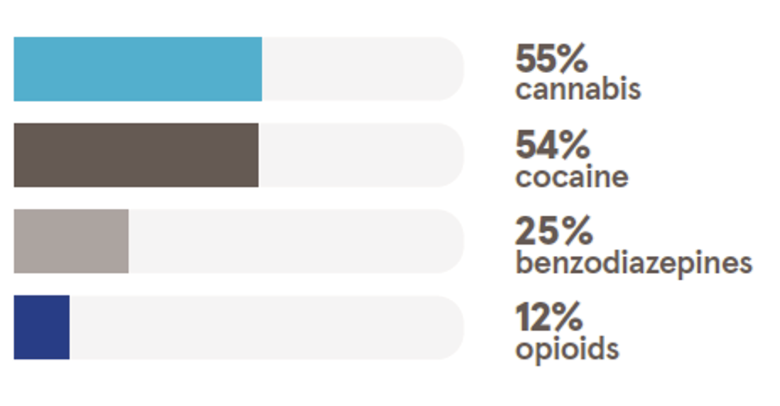O'Neill, Derek (2021) Alcohol treatment in Ireland, 2014–2020. Drugnet Ireland, Issue 79, Autumn 2021, pp. 30-32.
| Preview | Title | Contact |
|---|---|---|
|
PDF (Drugnet Ireland 79)
1MB |
Published in July 2021, the latest National Drug Treatment Reporting System (NDTRS) report presents trends in treated problem alcohol use for the seven-year period from 2014 to 2020.1
Key findings
Over the period, some 51,205 cases treated for problem alcohol use were reported to the NDTRS. The number of treated cases recorded decreased from 7,760 in 2014 to 5,824 in 2020 (see Table 1). Between 2019 and 2020, the number of treated cases decreased by 22.8%, from 7,546 cases to 5,824 cases. The overall drop in the number of cases entering alcohol treatment in 2020 is in part the result of temporary service closures and measures introduced to comply with Covid-19 restrictions and does not necessarily indicate a real decline in demand for treatment.
New cases (those never previously treated) accounted for 48.6% of cases in 2014 and 42.8% in 2020. Previously treated cases accounted for 49.1% of cases in 2014 and 54.4% in 2020.
In 2020, three in every five (60.2%) cases were treated in outpatient facilities, while 28.8% of cases were treated in inpatient facilities, 8% in low-threshold services, and 3% in prisons (see Table 2).
Between 2019 and 2020, the number of cases treated in residential settings decreased by 40.1%, from 2,806 cases to 1,680 cases. The reduction in residential case numbers can in part be attributed to temporary closures and measures introduced to comply with Covid-19 restrictions.
Table 1: Number of cases treated for alcohol as a main problem, by treatment status,

Table 2: Number of cases treated for alcohol as a main problem, by type of service provider, NDTRS 2014–2020

Focus on gender
The median age of female cases that entered treatment was 43 years compared with 40 years for male cases. Among new female cases specifically, the median age entering treatment was 41 years. This compared with a median age of 38 years among new male cases that entered treatment. Among female cases, 32.6% were aged 50 years or over compared with 25.7% of male cases aged 50 years or over. Among those treated for alcohol, homelessness was more common for males (10.7%) than females (4.8%).
The proportion of female cases reporting problem use of other drugs in addition to alcohol was 17%. The most common additional drugs for females were cocaine and cannabis. Rates of benzodiazepines and opioid use were found to be more common among females than males. One in four male cases (26.9%) reported problem use of other drugs in addition to alcohol. The common additional drugs for male cases were cannabis and cocaine.
Polydrug use
In 2020, some 23.1% of cases treated for problem alcohol use reported problem use of more than one substance (polydrug use) (see Table 3).
In 2020, cannabis (54.9%) was the most common additional drug reported by cases with polydrug use, followed by cocaine (54.1%) and benzodiazepines (24.6%) (see Figure 1). The proportion of cases reporting cannabis use decreased from 63.2% in 2014 to 54.9% in 2020. Problem use of cocaine increased from 28.2% in 2014 to 54.1% in 2020. The proportion of cases treated for benzodiazepines decreased from 27.9% in 2014 to 21.8% in 2019, then increased to 24.6% in 2020.
Table 3: Polydrug use in cases treated for problem alcohol use, NDTRS 2014–2020


Figure 1: Most common additional drugs in cases treated for problem alcohol use, NDTRS 2014–2020
Level of problem alcohol use
In 2020, the median age at which cases commenced alcohol use was 16 years. Over the period, the majority (66.1%) were classified as alcohol dependent (by the healthcare professionals treating them). The proportion of new cases (those never previously treated for problem alcohol use) that were classified as alcohol dependent decreased from a peak of 66.8% in 2017 to 57.2% in 2020.
Sociodemographic characteristics
The following sociodemographic characteristics of the cases were noted:
- The median age at which cases entered treatment has remained stable since 2015, at 41 years.
- The proportion of cases aged 17 years or younger has decreased from 2.1% in 2014 to 1.7% in 2020.
- The majority of cases in 2020 were male (61.9%), similar to previous years.
- The proportion of cases recorded as homeless increased from 6.4% in 2014 to 8.5% in 2020.
- In 2020, some 2.1% of cases identified as Irish Traveller.2
- In 2020, some 21.2% of cases reported ceasing education (for the first time) before the age of 16 years.
- Just under one-half of reported cases were unemployed; this rate decreased over the reporting period from 56.4% in 2014 to 49.2% in 2020.
- In each year, rates of homelessness, ceasing education before age 16, and unemployment were higher among previously treated cases than among new cases.
- In 2020, some 17.4% (n=1015) of cases treated for alcohol were residing with children aged 17 years or younger. The majority were females (57.4%, n=583), while males accounted for 42.6% (n=432).
- A similar number of cases (17.6%, n=1027) treated for alcohol in 2020 had children aged 17 years or younger who were not residing with them. Almost three-quarters of these cases (72.4%, n=744) were males, while one-quarter were females (27.6%, n=283).
1 O’Neill D, Carew AM and Lyons S (2021) National Drug Treatment Reporting System 2014–2020 alcohol treatment data. HRB StatLink Series 7. Dublin: Health Research Board. https://www.drugsandalcohol.ie/34164
2 Based on the 2016 Census, the proportion of Irish Travellers in the general population is 0.7%
(Central Statistics Office, 2019). Available online at: https://www.cso.ie/en/releasesandpublications/ep/p-cp8iter/p8iter/p8e/
G Health and disease > Substance use disorder (addiction) > Alcohol use disorder
J Health care, prevention, harm reduction and treatment > Treatment and maintenance > Treatment factors
J Health care, prevention, harm reduction and treatment > Health care programme, service or facility
VA Geographic area > Europe > Ireland
Repository Staff Only: item control page